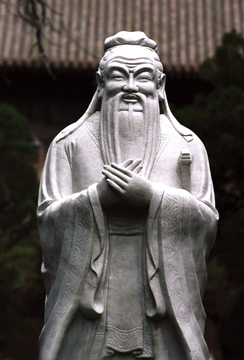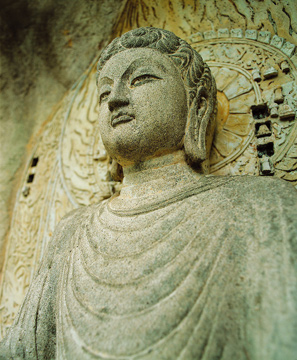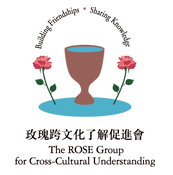Traditions of Chinese Thought
By Moss Roberts
China’s impact
 |
Learning without thinking will confuse you;
Thinking without learning is dangerous
— Confucianism
(儒教) |
|
Confucianism, Daoism, and Buddhism are the three schools of philosophy that have domi-nated Chinese culture. One might better call them "teachings” since there is no original Chinese word that means philosophy or for that matter religion. Confucianism is based on the teachings of Confucius, who died at age 73 in 479 B.C. He was primarily concerned with matters of ethics and politics, personal conduct and social order. He gave little attention to matters divine, and none to the supernatural. Daoism is based on the teachings of Laozi, who is thought to have lived about the time of Confucius or slightly later. Laozi framed human life not in a social but in a vastly larger natural context, treating man not as a leading subject but as no more than a minor part of the vast range of creation. Laozi called creation the “ten thousand things,” which he saw as driven through their cycles of life by the Dao or Way, a kind of force of nature. Lastly, Buddhism, which entered China from India in the middle of the first century A.D., advocated non-attachment to society and social relations, and commitment to a sacred community devoted to humble work and worship, in order to reach Nirvana by self-discipline.
After it entered China, Buddhism joined with Daoism as a philosophical cousin. Daoism emphasized the drastic scaling down of social life and the teaching of wu-wei or non-assertive conduct, while Buddhism emphasized non-attachment to the social world. Buddhism, unlike Daoism, however, is oriented not merely toward a distancing from the social world, but ultimately seeks to release man of all attachment to the world (Samsara) in preparation for a future reincarnation or ideally the end of reincarnation. Nirvana, often translated “extinction,” refers to the blowing out of the flames of passion and the overcoming of Karma (deeds and their effects).
 |
Dao gives life without possessing,
Performs without obligating,
Presides without controlling:
Such is the meaning of “hidden power.”
— Dao De Jin stanza 10, Daoism (道教) |
|
Confucianism thinks in terms of future generational time; Daoism in terms of naturally evolving time; Buddhism in terms of ending time.
In China the three teachings have reached a kind of mutual acceptance and influence that goes beyond Western notions of religious “toleration.” Thus, for example, Confucianism initially came into conflict with Buddhist teachings in the early centuries of Buddhist activity in China; but eventually compromises of doctrine and practice enabled the two teachings to co-exist. With its emphasis on individual appreciation of nature and its close association with art and poetry, Daoism complements the Confucian stress on duty, service, and honor. Unlike in the West where religions tend toward rivalry and exclusiveness, in China religions are normally inclusive. One can be Confucian, Buddhist, and Daoist, all together, or serially at different times, since each way of thinking speaks to different needs and issues. So for the Chinese, by and large, philosophy and religion are different angles of vision on the world rather than rigid belief-commitments.
 |
“to see things for what they are with clear consciousness, being aware of the present reality within oneself, without any craving or aversion”
— The Noble Eightfold Path, Buddhism (佛教) |
|
What are the distinctive features of each of these three schools of thought?
Confucianism is a doctrine of political order and authority that rests on a foundation of family-based values. Confucianism’s central teaching is called Ren, usually translated “benevolence,” which describes the extension of idealized family relations to the world at large, similar to what is suggested by the phrase “family of man.” The idea is preserved in the term guojia (state-family) which the Chinese still use to refer to their country or nation-state. Ancestor worship, or more simply respect for elders and for history, plays a major role in Confucianism. But Confucianism also focuses on the future, seeking to integrate current and future developments into the traditions of the past. It might be seen at its best as forward-looking conservatism. Daoism seeks to minimize the influence of political and social authority so that all ten thousand things (man included) can be as free as possible to develop their own capacities and potential. This comes under the doctrine of wu-wei or non-assertiveness. Daoists turned away from the idea of ancestor worship and family structure precisely because they limited the freedom of things to be as they are naturally, a state described by the Chinese term “ziran.”
Over the long course of Chinese history Buddhism adapted itself to the two major indigenous ways of thinking, Confucianism and Daoism. Buddhist temples became part of their communities rather than havens of refuge for those who sought a life apart. In doctrine, this meant that the way of the world, Samsara, and Nirvana, were redefined as part of each other, overlapping and intertwined. The identification of Nirvana and Samsara had a social aspect. Under the aegis of Guanyin, the Goddess of Mercy, who declined to enter Nirvana in order to minister to mankind, many Buddhists have undertaken a life of service to those who suffer in this samsara world. Thus, if Buddhist ideals could be realized within conventional social roles, then Buddhism and Confucianism could be reconciled, while Daoism held its long honored place as a philosophy of man’s identification with nature.
Moss Roberts, Professor of Chinese in the Department of East Asian Studies, New York University; editor and translator of Chinese Fairy Tales & Fantasies (Pantheon 1978); editor and translator of Three Kingdoms: A Historical Novel (University of California Press 1992); editor and translator of Dao De Jing: The Book of the Way (University of California Press 2002). All three are available in paperback. |
|



